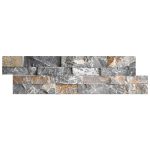Introduction
Cultured stone pillars have long been revered for their timeless elegance and enduring beauty. These architectural elements have been used throughout history to add a touch of sophistication and grandeur to buildings and structures. In this article, we will explore the history, characteristics, and advantages of cultured stone pillars, as well as their various applications in modern architecture.
History of Cultured Stone Pillars
The use of stone pillars in architecture dates back to ancient times, with civilizations such as the Greeks and Romans incorporating them into their buildings to convey strength, stability, and grandeur. These early pillars were typically made of natural stone, which was carved and shaped by hand to create intricate designs and decorative elements.
Over time, the process of creating stone pillars evolved, leading to the development of cultured stone. Cultured stone is a composite material that mimics the look and feel of natural stone but is lighter in weight and more versatile in terms of design and application. Cultured stone pillars became increasingly popular in architecture due to their durability, affordability, and ease of installation.
Characteristics of Cultured Stone Pillars
Cultured stone pillars are made from a mixture of cement, aggregates, and pigments that are molded and cast into various shapes and sizes. The resulting product closely resembles natural stone in terms of color, texture, and durability. Cultured stone pillars can be customized to mimic a wide range of natural stone types, including limestone, marble, granite, and travertine.
One of the key characteristics of cultured stone pillars is their versatility in design. They can be crafted in a variety of shapes and styles, from simple and understated to ornate and elaborate. This flexibility allows architects and designers to create custom pillars that complement the overall aesthetic of a building or structure.
Another important characteristic of cultured stone pillars is their durability. Unlike natural stone, which can be prone to cracking and weathering over time, cultured stone is engineered to withstand the elements and maintain its appearance for years to come. Cultured stone pillars are also resistant to moisture, mold, and pests, making them an ideal choice for both interior and exterior applications.
Advantages of Cultured Stone Pillars

There are several advantages to using cultured stone pillars in architectural design. One of the primary benefits is cost-effectiveness. Cultured stone is typically more affordable than natural stone, making it a budget-friendly option for projects that require the look of stone without the high price tag. Additionally, the lightweight nature of cultured stone makes it easier and more cost-effective to transport and install compared to heavy natural stone.
Another advantage of cultured stone pillars is their ease of maintenance. Unlike natural stone, which may require regular sealing and cleaning to preserve its appearance, cultured stone is relatively low-maintenance and can be cleaned with a simple soap and water solution. This makes cultured stone pillars a practical choice for homeowners and business owners looking for a durable and long-lasting architectural element.
In addition to cost-effectiveness and ease of maintenance, cultured stone pillars offer a wide range of design possibilities. With the ability to customize the color, texture, and shape of the pillars, architects and designers can create unique and visually striking focal points in their projects. Cultured stone pillars can be used to enhance the exterior of a building, define entryways, or add a touch of elegance to interior spaces.
Applications of Cultured Stone Pillars
Cultured stone pillars have a wide range of applications in modern architecture, from residential homes to commercial buildings and public spaces. One common use of cultured stone pillars is in the construction of entryways and porches. By incorporating pillars into the design of an entry, architects can create a grand and welcoming entrance that sets the tone for the rest of the building.
Cultured stone pillars are also commonly used in the construction of outdoor living spaces, such as patios, pergolas, and gazebos. These pillars can be used to support overhead structures, provide visual interest, and create a sense of enclosure in outdoor areas. Cultured stone pillars are particularly well-suited for outdoor applications due to their durability and resistance to the elements.
In addition to residential and outdoor applications, cultured stone pillars are often used in the design of commercial buildings, such as hotels, restaurants, and retail stores. These pillars can be used to create a sense of luxury and sophistication, as well as to define architectural features and provide structural support. Cultured stone pillars are also popular in public spaces, such as museums, libraries, and government buildings, where they can add a sense of history and permanence to the design.
Conclusion
Cultured stone pillars have a rich history and a timeless elegance that continues to be appreciated in modern architecture. With ledge stone for sale , affordability, and versatility in design, cultured stone pillars are a popular choice for architects and designers looking to add a touch of sophistication and grandeur to their projects. Whether used in residential homes, commercial buildings, or public spaces, cultured stone pillars are sure to make a lasting impression for years to come.
